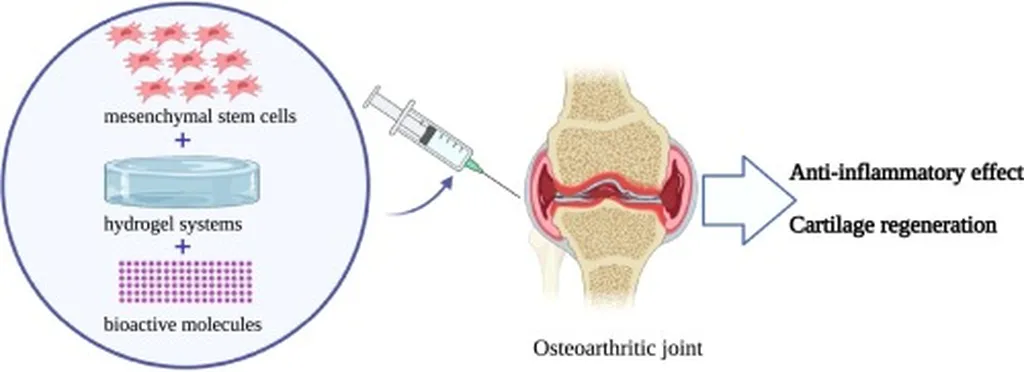In the relentless pursuit of effective osteoarthritis (OA) treatments, a groundbreaking study led by Chenyuan Gao from the State Key Laboratory of Organic-Inorganic Composites at Beijing University of Chemical Technology and the Peking University Third Hospital has unveiled a promising strategy that combines pre-conditioned stem cells with an adaptive hydrogel. This innovative approach, published in the journal *Bioactive Materials* (which translates to *Materials with Biological Activity*), could potentially revolutionize the way we manage this debilitating joint disease.
Osteoarthritis, a chronic joint condition affecting millions worldwide, currently lacks a definitive cure. Mesenchymal stromal cells (MSCs) have shown potential in OA management, but their direct administration faces significant hurdles, including rapid clearance from the joint cavity and limited survival in the inflammatory environment. Gao and his team have addressed these challenges by pre-conditioning MSCs with magnesium ions (Mg2+) and a hypoxia-mimicking agent called dimethyloxalylglycine (DMOG), integrated within a self-healing, tissue-adhesive hydrogel.
The hydrogel, composed of phenylboronic acid and methacrylate-modified hyaluronic acid (HAMA-PBA), ensures localized and sustained delivery of the pre-conditioned MSCs. “This hydrogel not only retains the cells at the injury site but also enhances their functionality,” explains Gao. The Mg2+ component regulates macrophage polarization towards an anti-inflammatory phenotype, inhibits osteoclast activation, and preserves subchondral bone integrity by activating the PI3K-Akt signaling pathway. Meanwhile, DMOG activates the HIF-1α pathway, mimicking a hypoxic microenvironment that supports chondrocyte repair and stimulates cartilage matrix synthesis.
In vivo studies demonstrated significant reductions in joint inflammation, enhanced cartilage regeneration, and improved joint function. “The synergistic effects of biochemical preconditioning and biomaterial-enabled delivery offer a robust therapeutic strategy for OA treatment,” says Gao. This research could pave the way for more effective and targeted treatments for osteoarthritis, potentially reducing the need for more invasive procedures and improving the quality of life for millions of patients.
The commercial implications of this research are substantial. The development of advanced biomaterials and cell-based therapies represents a growing market with significant potential. As the global population ages, the demand for effective OA treatments is expected to rise, making this research not only scientifically significant but also economically impactful. The energy sector, particularly in the realm of regenerative medicine, could benefit from the advancements in biomaterial science and cell therapy, driving innovation and investment in this burgeoning field.
This study highlights the importance of interdisciplinary research, combining biomaterials, cell biology, and clinical applications to address complex medical challenges. As we look to the future, the integration of such innovative approaches may well redefine the landscape of regenerative medicine, offering new hope for patients suffering from osteoarthritis and other degenerative diseases.

